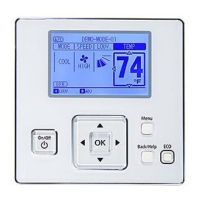IFC-3030 Programming Manual — P/N 52025:C 08/05/2005 29
Panel Program Program
MODE: Press this soft key to enter the ACS mapping mode. Refer to the following chart for
possible mode choices and descriptions of their functions.
SOURCE: Pressing this soft key will select the Source field and also toggle between display
formats if a point value is allowed. Enter a point or zone, or the panel’s node number if the mode
type is a system function such as acknowledge or reset.
Up to eight sources are allowed when CONTROL mode is chosen.
ACCEPT: Press this soft key to save the changes to the point displayed. The next point address will
appear.
BACK: Press this soft key to exit the screen without saving, and return to the ACS Programming
Screen.
ACS Point
Mode
Function
The point...
Explanation
None is not programmed. No messages are sent from or received at this point. LEDs at this
point do not light.
Control will change the state of up to eight panel
circuits or control modules to off or on
when its button is pushed.
The Point Active LED is lit if a corresponding mapped point is
active. The Status (trouble) LED is on when a point or zone is
disabled or in trouble.
This mode is not for use with an ACS point with no switch, or with
a TM-4 or UDACT.
Monitor will show the current status of a specified
point or zone.
The Point Active LED is lit if the corresponding mapped point or
zone is active. The Status (trouble) LED is on if that point or zone
is disabled or in trouble. If the point has a button, it has no effect
when pushed.
Telephone supports telephone functionality when
mapped to a telephone point. Press the
button to connect the mapped point with
the telephone station.
Both the Point Active LED and the Status (trouble) LED will flash
if a telephone has been placed in the jack at the mapped
telephone point. Otherwise, the Point Active LED is lit if the
corresponding point or zone is active. The Status (trouble) LED is
lit if that point or zone is in trouble or disabled.
This mode is for use with ACS Series annunciator points
configured for telephone operation.
Disable will change the state of a point or zone
specified through mapping from enabled
to disabled, or from disabled to enabled,
when its button is pushed.
See Caution below this table.
The Point Active LED is lit if the corresponding mapped point or
zone is active. The Status (trouble) LED is lit if that point or zone
is disabled or in trouble.
This mode is not for use with an ACS point with no switch, or with
a TM-4, UDACT, or smoke control device.
Acknowledge will act like an Acknowledge soft key or
button on the panel, acknowledging an
event when its button is pushed.
The Point Active LED is lit when there are any fire alarms in the
system. The Status (trouble) LED is lit when there are troubles in
the system.
Silence will act like the Signal Silence button on
the panel, silencing all silenceable
outputs when its button is pushed.
The Point Active LED is lit if all silenceable outputs have been
silenced. The Status (trouble) LED is lit if not all silenceable
outputs have been silenced after the button is pushed.
Reset will act like the System Reset button on
the panel, resetting the panel when its
button is pushed.
No LED will ever light at this point.
This mode is not for use with an ACS point with no switch, or with
a TM-4, UDACT, or smoke control device.
Drill will act like the Drill button on the panel,
initiating a fire drill when its button is
pushed.
The Point Active LED lights when the button is pushed and the
system has entered the drill state. The Status (trouble) LED will
never light.
This mode is not for use with an ACS point with no switch, or with
a TM-4, UDACT, or smoke control device.
!
CAUTION: When a disabled output is enabled, it will be affected by conditions existing in the
system that would normally affect it. For example, when a condition exists in the system that would
normally turn the output on, the output will turn on when it is enabled.

